Abstract
Background
Complex regional pain syndrome (CRPS) is a chronic disabling painful disorder with limited options to achieve therapeutic relief. CRPS type I which follows trauma, may not show obvious damage to the nervous structures and remains dubious in its pathophysiology and also its response to conservative treatment or interventional pain management is elusive. Spinal cord and dorsal root ganglion stimulation (SCS, DRGS) provide good relief, mainly for causalgia or CRPS I of lower extremities but not very encouraging for upper extremity CRPS I. we reported earlier, a case of CRPS I of right arm treated successfully by wireless peripheral nerve stimulation (WPNS) with short term follow up. Here we present 1-year follow-up of this patient.
Objective
To present the first case of WPNS for CRPS I with a year follow up. The patient had minimally invasive peripheral nerve stimulation (PNS), without implantable pulse generator (IPG) or its accessories.
Case report
This was a case of refractory CRPS I after blunt trauma to the right forearm of a young female. She underwent placement of two Stimwave electrodes (Leads: FR4A-RCV-A0 with tines, Generation 1 and FR4A-RCV-B0 with tines, Generation 1) in her forearm under intraoperative electrophysiological and ultrasound guidance along radial and median nerves. This WPNS required no IPG. At high frequency (HF) stimulation (HF 10 kHz/32 μs, 2.0 mA), patient had shown remarkable relief in pain, allodynia and temperature impairment. At 5 months she started driving without opioid consumption, while allodynia disappeared. At 1 year follow up she was relieved of pain [visual analogue scale (VAS) score of 4 from 7] and Kapanji Index (Score) improved to 7–8. Both hands look similar in color and temperature. She never made unscheduled visits to the clinic or visited emergency room for any complications related to the WPNS.
Conclusions
CRPS I involving upper extremity remain difficult to manage with conventional SCS or DRGS because of equipment related adverse events. Minimally invasive WPNS in this case had shown consistent relief without any complications or side effects related to the wireless technology or the technique at the end of 1 year.
Implications
This is the first case illustration of WPNS for CRPS I, successfully treated and followed up for 1 year.
1 Introduction
According to the International Association for the Study of Pain (IASP), complex regional pain syndrome (CRPS) type I, a reflex sympathetic dystrophy, is defined by hyperalgesia, discoloration of skin, allodynia, abnormal sudomotor/vasomotor/motor functions and swelling of the extremity secondary to a noxious event without anatomical nerve damage, while the distribution of the symptomatology defies dermatomal topography or the degree of disability or suffering [1], [2], [3]. The exact etiology of CRPS still remains unknown and it is essentially a clinical diagnosis without any specific laboratory tests to clinch the entity. However findings on radiographic, electrophysiological and diagnostic nerve blocks provide some information pointing towards this disease [4].
As a result of enigmatic pathophysiology presenting with mixed somatic and autonomic symptoms, management of CRPS requires combination of medical, psychological, interventional and neuromodulation methods like spinal cord stimulation (SCS) and peripheral nerve stimulation (PNS); often recommending earlier intervention to reduce disability [5], [6]. Even then, patient selection for either SCS or PNS is not simple because of the immunological, neurological, psychological and genetic factors engaged in the etio-pathogenesis of CRPS [7], [8], [9], [10].
Additionally, there is paucity of data on the long term effectiveness of traditional SCS in the treatment of CRPS [11], [12].
Hewitt NA and Cox P reported the hepatotoxicity of long term Ketamine infusion in CRPS [13].
We reported our experience with wireless PNS in the management of CRPS type I of the upper extremity, earlier [14]. The following is the outcome of this patient at 1 year follow up.
2 Case illustration
Earlier we described the presentation of this CRPS type I, in detail. This young female patient presented with relentless progression of symptoms following blunt trauma to her right hand 7 years back. She had sensory and motor impairment of her right hand along with impaired temperature sensations and vivid discoloration of hand. Preoperative Kapandji score was 4 and visual analogue scale (VAS) score was 7. Following failed conservative medical management, nerve blocks, ketamine infusion therapy and opioids she underwent wireless neuromodulation treatment.
Surgical treatment: After obtaining informed written consent patient underwent placement of Stimwave leads (Stimwave Technologies, Fort Lauderdale, FL, USA) Two stimulating implantable electrodes (Leads: FR4A-RCV-A0 with tines, Generation 1 and FR4A-RCV-B0 with tines, Generation 1) were placed under ultrasonographic (USG) monitoring along median and radial nerve on the volar aspect of right forearm. At 60 Hz and 300 μs, intraoperative stimulation induced paresthesia along the nerve distribution. Once intraoperative radiography confirmed appropriate positioning, a stimulation protocol (high frequency [HF] 10 kHz/32 μs, 2.0 mA) was initiated for best therapeutic relief.
Soon after implantation, VAS score came down to 4 and her sensory symptoms improved. After 5 months, allodynia disappeared, allowing her to drive a car while opioid consumption was no longer required.
1-year follow-up:
She was examined after 1 year in detail. During this 1 year she never made any emergency calls or visits to the emergency room. Pain reduced to VAS score of 4, Kapandji Index improved to 7–8 with better movements of fingers. Color of the hand returned to normal with normal temperature sensation. There was a small residual painful area (Photograph 1) proximal to the electrodes on palmar aspect of the forearm (2×4 cm). Occasionally she used Ketamine nasal spray (5 mg/hub).
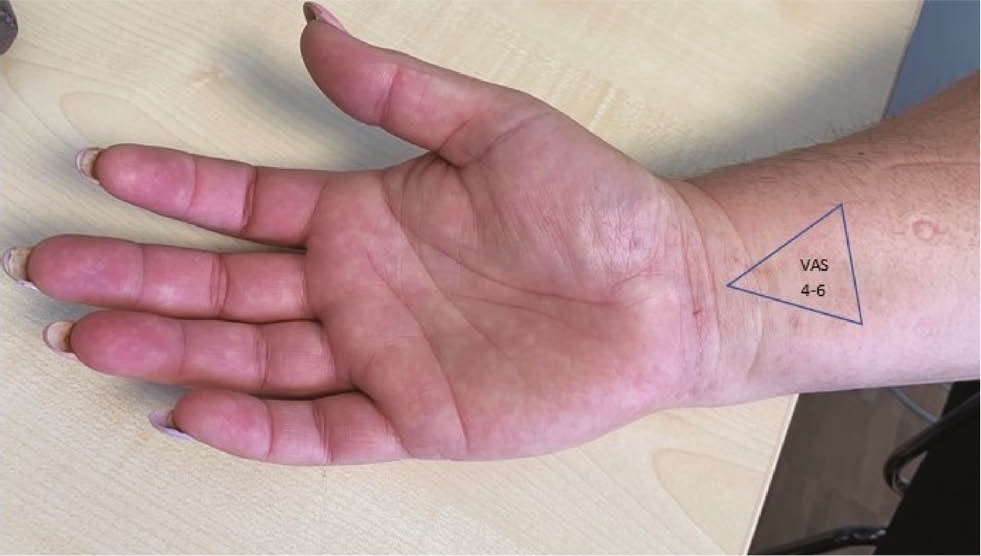
She used three programs during this time. With Program 1, she kept low power transmission with power index 24 (Fig. 1). Program II delivered the most comfortable relief at 1.5 kHz (Fig. 2), 3.0 mA and Program III with 10 kHz, 2.0 mA was intermittently applied (Fig. 3). She used stimulation at different times during the day depending upon the intensity of pain; mostly either during driving or in the night. The most acceptable component of the wireless peripheral nerve stimulation (WPNS) to her was the peripheral band, the wearable antenna, with a longer than usual (100 cm) cable that she can pull out through the sleeve, while the transmitter remained in the pocket. A stimulation with the StimPod (TM) for approx. five minutes at 8mAmp 2 Hz showed a significant reduction in the painful area for about 3 days.
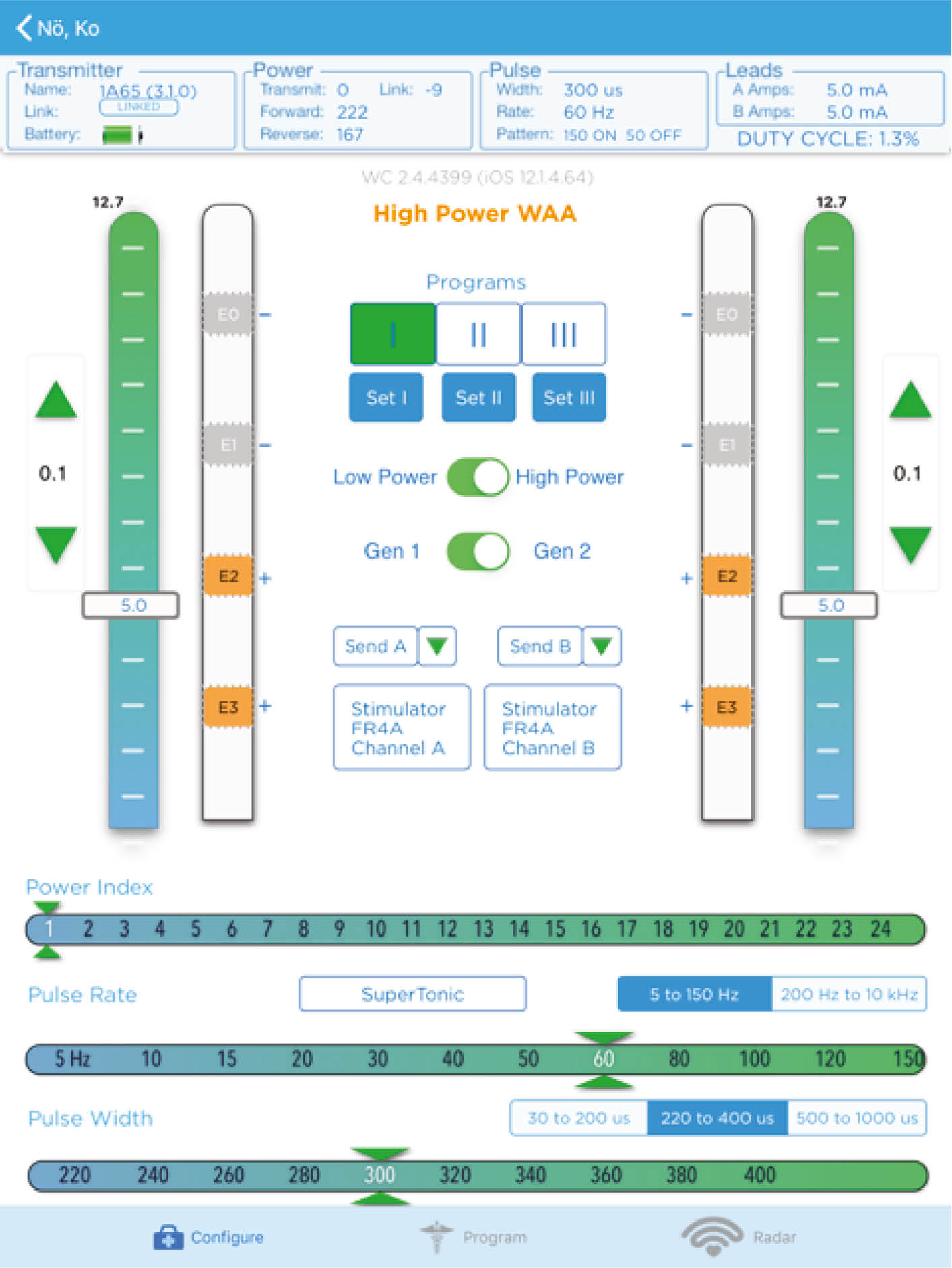
Stimulation protocol-Program I.
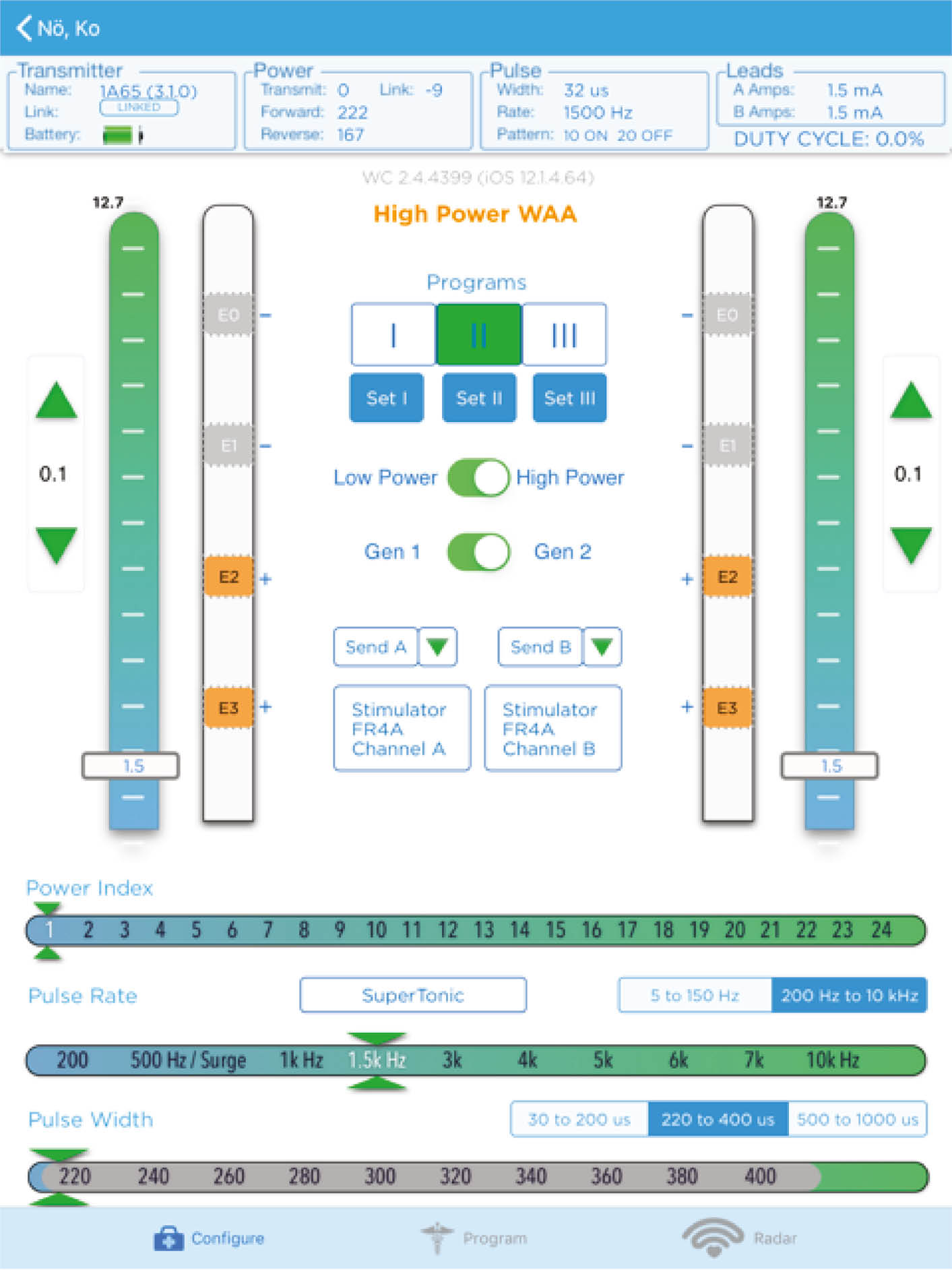
Stimulation protocol-Program II.

Stimulation protocol-Program III.
At present, after 15 months, patient came with improved symptomatology and functional abilities. She was able to drive her car and perform daily activities without much impediment. However, a small area (about 2 cm×4 cm) of allodynia close to her wrist on the palmar aspect, unresponsive to stimulation. This required pregabalin (200 mg twice a day) and oxycontin+naloxone (twice a day) with intermittent Ketamine nasal spray on demand.
Follow up radiographs of the forearm and hand were obtained to verify the location of the implanted electrodes (Figs. 4 and 5). Both anterior-posterior (Fig. 4) and lateral (Fig. 5) views confirmed appropriate placement of two electrodes along the median and radial nerves.
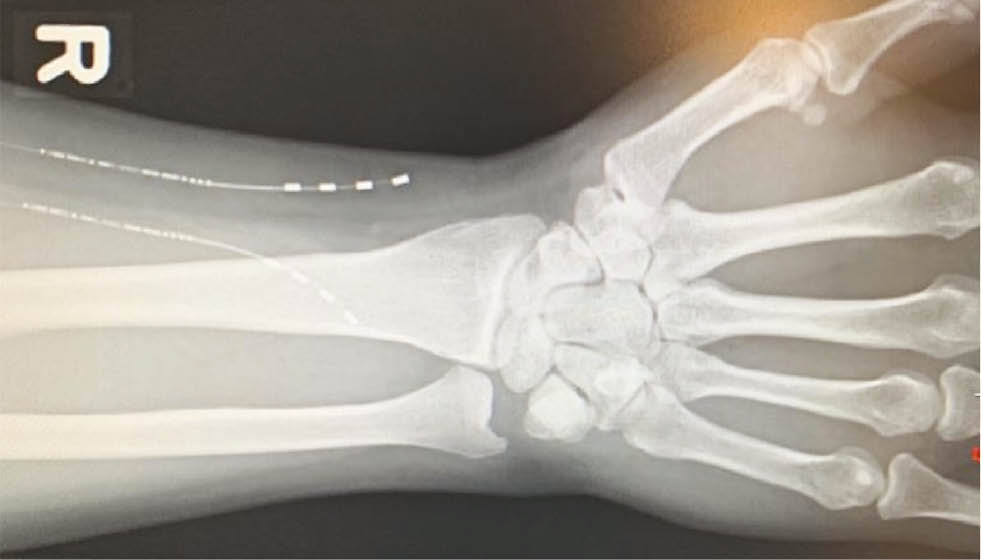
Anterior-posterior X-ray of the forearm demonstrating the location of the implanted electrodes in-situ.
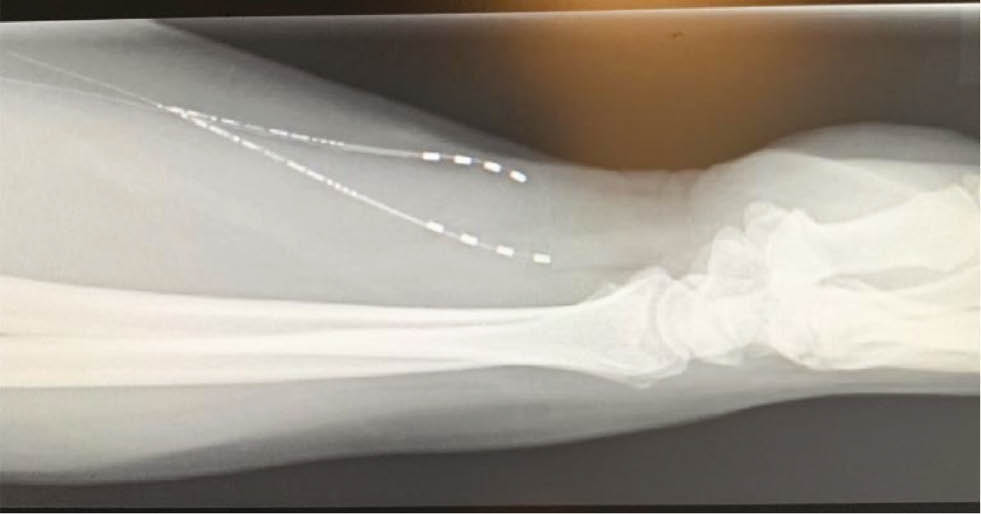
Lateral radiograph of the forearm disclosing the position of the implants at the required anatomical site.
3 Discussion
CRPS is an extremely disabling, refractory painful disorder affecting 16,000–78,000 people each year [10], [15], [16].
It has a challenging presentation for early diagnosis and effective treatment since the etiology remains obscure [4], [17]. Protocol for effective treatment includes patient education, physical therapy (PT) and interventional management [18], [19], [20], which was negatively influenced by diagnostic delay [21]. The goal of early neuromodulation would be restoration of motor function of the involved extremities for active rehabilitation [22], [23].
Upper extremity CRPS is particularly difficult to manage because of the anatomy of the sympathetic chain: the postganglionic fibers coming from the 2nd and 3rd sympathetic ganglia and the nerve of Kuntz, which requires SCS at both cervical and thoracic levels [24], [25]. In addition to this anatomical complexity, positional changes dampen the efficacy of traditional SCS [26].
Both SCS and dorsal root ganglion stimulation (DRGS) demonstrated efficacy when combined with PT in the initial follow up [5], [27], [28]. However, 5-year follow up results did not show better outcome with SCS and PT compared to PT alone; a complication rate of 38% was reported with SCS after 2 years [29] while 9/24 patients underwent reoperation. Authors concluded that SCS “did not produce durable and statistically significant improvements in the pain from CRPS-I” [29].
Some authors proposed “stim vacation” to improve the outcomes but had very little success in reducing CRPS relapsing during SCS therapy [12].
Traditional SCS was also reported to have additional adverse events and revision surgeries due to implantable power generator (IPG) related adverse events and failures in 46% of CRPS cases. Revision of electrodes was needed in 25%, lead migrations in 46% and IPG pain indicated surgery for replacement in 33% [11]. DRGS also had similar number of adverse events and additional surgeries [30].
WPNS, on the other hand, requires implantation of the electrodes only without IPG. In a complicated disease like CRPS of upper extremity, WPNS is best suited since anatomically the leads could be implanted in close proximity to the peripheral nerves with ease of revision, if required. The wireless device has no tethering due to IPG or its accessories and additional anchors [31]. There have been successful case reports on wireless neuromodulation with short term follow up [14], [32], [33].
The present case illustrated the simplicity of the implant and good relief achieved with a novel wireless technology in PNS. After the implantation patient had the option to use three programs viz. 60 Hz, 10 kHz, and 1.5 kHz during the trial phase. She perceived comfort at 10 kHz frequency during the initial period. However, at the subsequent sessions for programing, according to her, the best result was provided by 1.5 kHz stimulation for pain relief. At present, she has 1.5 kHz program along with another LF 60 Hz program available for use (which she uses mainly for checking the system functionality but not for therapy).
The patient had no adverse events or complications related to the technique or the technology and was tolerated very well by the patient. She never made any emergency call or any unscheduled visits to the emergency room or the clinic. At the end of 1 year and 3 months, she remains relieved of the disabling symptoms of CRPS, leading normal life, driving her car. Patient also enjoys the simplicity and flexibility of the frequencies available for pain relief.
Abbreviations: ACCURATE, a safety and effectiveness trial of spinal cord stimulation of the dorsal root ganglion for chronic lower limb pain; CRPS, complex regional pain syndrome; DRGS, dorsal root ganglion stimulation; FDA, Food and Drug Administration; HF, high frequency; IASP, International Association for the Study of Pain; IPG, implantable power generator; PNS, peripheral nerve stimulation; PT, physical therapy; SCS, spinal cord stimulation; VAS, Visual Analogue Scale; WPNS, wireless peripheral nerve stimulation.
Acknowledgements
The authors are thankful to Dr. Prasad Vannemreddy for his guidance with research and preparation of the manuscript.
-
Authors’ statements
-
Research funding: None
-
Conflict of interest: None
-
Informed consent: Obtained
-
Ethical approval: Obtained
References
[1] Merskey H, Bogduk N, International Association for the Study of Pain. Task Force on Taxonomy. Classification of Chronic Pain: Descriptions of Chronic Pain Syndromes and Definitions of Pain Terms, 2nd ed. Seattle: IASP Press, 1994:xvi, 222 p.Search in Google Scholar
[2] Harden RN, Bruehl S, Stanton-Hicks M, Wilson PR. Proposed new diagnostic criteria for complex regional pain syndrome. Pain Med 2007;8:326–31.10.1111/j.1526-4637.2006.00169.xSearch in Google Scholar PubMed
[3] Harden RN, Bruehl S, Perez RS, Birklein F, Marinus J, Maihofner C, Lubenow T, Buvanendran A, Mackey S, Graciosa J, Moqilevski M, Ramsden C, Chont M, Vatine JJ. Validation of proposed diagnostic criteria (the “Budapest Criteria”) for Complex Regional Pain Syndrome. Pain 2010;150:268–74.10.1016/j.pain.2010.04.030Search in Google Scholar PubMed PubMed Central
[4] Bruehl S. An update on the pathophysiology of complex regional pain syndrome. Anesthesiology 2010;113:713–25.10.1097/ALN.0b013e3181e3db38Search in Google Scholar PubMed
[5] Kumar K, Rizvi S, Bnurs SB. Spinal cord stimulation is effective in management of complex regional pain syndrome I: fact or fiction. Neurosurgery 2011;69:566–78.10.1227/NEU.0b013e3182181e60Search in Google Scholar PubMed
[6] Poree L, Krames E, Pope J, Deer TR, Levy R, Schultz L. Spinal cord stimulation as treatment for complex regional pain syndrome should be considered earlier than last resort therapy. Neuromodulation 2013;16:125–41.10.1111/ner.12035Search in Google Scholar PubMed
[7] van de Beek WJ, Roep BO, van der Slik AR, Giphart MJ, van Hilten BJ. Susceptibility loci for complex regional pain syndrome. Pain 2003;103:93–7.10.1016/S0304-3959(02)00444-XSearch in Google Scholar PubMed
[8] Kohr D, Singh P, Tschernatsch M, Kaps M, Pouokam E, Diener M, Kummer W, Birklein F, Vincent A, Goebel A, Wallukat G, Blaes F. Autoimmunity against the beta2 adrenergic receptor and muscarinic-2 receptor in complex regional pain syndrome. Pain 2011;152:2690–700.10.1016/j.pain.2011.06.012Search in Google Scholar PubMed
[9] Margalit D, Ben Har L, Brill S, Vatine JJ. Complex regional pain syndrome, alexithymia, and psychological distress. J Psychosom Res 2014;77:273–7.10.1016/j.jpsychores.2014.07.005Search in Google Scholar PubMed
[10] Kemler MA, de Vet HC. Health-related quality of life in chronic refractory reflex sympathetic dystrophy (complex regional pain syndrome type I). J Pain Symptom Manage 2000;20:68–76.10.1016/S0885-3924(00)00170-6Search in Google Scholar
[11] Visnjevac O, Costandi S, Patel BA, Azer G, Agarwal P, Bolash R, Mekhail N. A comprehensive outcome-specific review of the use of spinal cord stimulation for complex regional pain syndrome. Pain Practice 2017;17:533–45.10.1111/papr.12513Search in Google Scholar PubMed
[12] Muquit S, Moussa AA, Basu S. Pseudofailure of spinal cord stimulation for neuropathic pain following a new severe noxious stimulus: learning points from a case series of failed spinal cord stimulation for complex regional pain syndrome and failed back surgery syndrome. Br J Pain 2016;10:78–83.10.1177/2049463715622795Search in Google Scholar PubMed PubMed Central
[13] Hewitt NA, Cox P. Recurrent subanesthetic ketamine infusions for complex regional pain syndrome leading to biliary dilation, jaundice, and cholangitis: a case report. A A Pract 2018;10:168–70.10.1213/XAA.0000000000000650Search in Google Scholar PubMed
[14] Herschkowitz D, Kubias J. Wireless peripheral nerve stimulation for complex regional pain syndrome type I of the upper extremity: a case illustration introducing a novel technology. Scand J Pain 2018;18:555–60.10.1515/sjpain-2018-0014Search in Google Scholar PubMed
[15] de Mos M, de Bruijn AG, Huygen FJ, Dieleman JP, Stricker BH, Sturkenboom MC. The incidence of complex regional pain syndrome: a population-based study. Pain 2007;129:12–20.10.1016/j.pain.2006.09.008Search in Google Scholar PubMed
[16] Allen G, Galer BS, Schwartz L. Epidemiology of complex regional pain syndrome: a retrospective chart review of 134 patients. Pain 1999;80:539–44.10.1016/S0304-3959(98)00246-2Search in Google Scholar PubMed
[17] de Mos M, Sturkenboom MC, Huygen FJ. Current understandings on complex regional pain syndrome. Pain Pract 2009;9:86–99.10.1111/j.1533-2500.2009.00262.xSearch in Google Scholar PubMed
[18] Raja SN, Grabow TS. Complex regional pain syndrome I (reflex sympathetic dystrophy). Anesthesiology 2002;96:1254–60.10.1097/00000542-200205000-00031Search in Google Scholar PubMed
[19] Beerthuizen A, Stronks DL, Van’tSpijker A, Yaksh A, Hanraets BM, Klein J, Huygen FJ. Demographic and medical parameters in the development of complex regional pain syndrome type 1 (CRPS1): prospective study on 596 patients with a fracture. Pain 2012;153:1187–92.10.1016/j.pain.2012.01.026Search in Google Scholar PubMed
[20] Zyluk A. Complex regional pain syndrome type I. Risk factors, prevention and risk of recurrence. J Hand Surg Br 2004;29:334–7.10.1016/J.JHSB.2004.01.003Search in Google Scholar PubMed
[21] Shenker N, Goebel A, Rockett M, Batchelor J, Jones GT, Parker R, de C Williams AC, McCabe C. Establishing the characteristics for patients with chronic complex regional pain syndrome: the value of the CRPS-UK Registry. Br J Pain 2015;9:122–8.10.1177/2049463714541423Search in Google Scholar PubMed PubMed Central
[22] Deer TR, Mekhail N, Provenzano D, Pope J, Krames E, Thomson S, Raso L, Burton A, DeAndres J, Buchser E, Buvanendran A, Liem L, Kumar K, Rizvi S, Feler C, Abejon D, Anderson J, Eldabe S, Kim P, Leong M, et al. Neuromodulation Appropriateness Consensus Committee. The appropriate use of neurostimulation of the spinal cord and peripheral nervous system for the treatment of chronic pain and ischemic diseases: the Neuromodulation Appropriateness Consensus Committee. Neuromodulation 2014;17:515–50.10.1111/ner.12206Search in Google Scholar PubMed
[23] Johnson S, Ayling H, Sharma M, Goebel A. External noninvasive peripheral nerve stimulation treatment of neuropathic pain: a prospective audit. Neuromodulation 2015;18:384–91.10.1111/ner.12244Search in Google Scholar PubMed
[24] Alexander WF, Kuntz A, Henderson WP, Ehrlich E. Sympathetic ganglion cells in ventral nerve roots: their relation to sympathectomy. Science 1949;109:484.10.1126/science.109.2837.484Search in Google Scholar PubMed
[25] Hoffman HH, Jacobs MW, Kuntz A. Nerve fiber components of communicating rami and sympathetic roots in man. Anat Rec 1956;126:29–41.10.1002/ar.1091260104Search in Google Scholar PubMed
[26] Van Buyten J-P, Smet I, Liem L, Russo M. Huygen Stimulation of dorsal root ganglia for the management of complex regional pain syndrome:a prospective case series. Pain Pract 2014;15:208–16.10.1111/papr.12170Search in Google Scholar PubMed
[27] Kemler MA, Barendse GA, van Kleef M, de Vet HC, Rijks CP, Furnee CA, van den Wildenberg FA. Spinal cord stimulation in patients with chronic reflex sympathetic dystrophy. N Engl J Med 2000;343:618–24.10.1056/NEJM200008313430904Search in Google Scholar PubMed
[28] Geurts JA, Smits H, Kemler MA, Brunner F, kessles AG, van Kleef M. Spinal cord stimulation for complex regional pain syndrome type I: a prospective cohort study with long-term follow-up. Neuromodulation 2013;16:523–9.10.1111/ner.12024Search in Google Scholar PubMed
[29] Kemler MA, de Vet HCW, Barendse GAM, van den Wildenberg FAJM, van Kleef M. Effect of spinal cord stimulation for chronic complex regional pain syndrome Type I: five-year final follow-up of patients in a randomized controlled trial. J Neurosurg 2008;108:292–8.10.3171/JNS/2008/108/2/0292Search in Google Scholar PubMed
[30] Deer TR, Levy RM, Kramer J, Poree L, Amirdelfan K, Grigsby E, Staats P, Burton AW, Burgher AH, Obray J, Scowcroft J, Golovac S, Kapural L, Paicius R, Kim C, Pope J, Yearwood T, Samuel S, McRoberts WP, Cassim H, et al. Dorsal root ganglion stimulation yielded higher treatment success rate for complex regional pain syndrome and causalgia at 3 and 12 months: a randomized comparative trial. Pain 2017;158:669–81.10.1097/j.pain.0000000000000814Search in Google Scholar PubMed PubMed Central
[31] Yearwood TL, Perryman LT. Peripheral neurostimulation with a microsize wireless stimulator. ProgNeurolSurg 2015;29: 168–91.10.1159/000434670Search in Google Scholar PubMed
[32] Billet B, Wynendaele R, Vanquathem NE. A novel minimally invasive wireless technology for neuromodulation via percutaneous nerve stimulation for post-herpetic neuralgia. A case report with short term follow up. Pain Pract 2017;18:374–9.10.1111/papr.12607Search in Google Scholar PubMed
[33] Weiner RL, Garcia CM, Vanquathem NE. A novel miniature wireless neurostimulator in the management of chronic craniofacial pain: Preliminary results from a prospective pilot study. Scand J Pain 2017;17:350–4.10.1016/j.sjpain.2017.09.010Search in Google Scholar PubMed
©2019 Scandinavian Association for the Study of Pain. Published by Walter de Gruyter GmbH, Berlin/Boston. All rights reserved.
Articles in the same Issue
- Frontmatter
- Editorial comment
- Quadratus lumborum block for the benefit of patients after full abdominoplasty?
- Systematic review
- Low-grade inflammation causes gap junction-coupled cell dysfunction throughout the body, which can lead to the spread of systemic inflammation
- Topical reviews
- Chronic Fatigue Syndrome and chronic pain conditions – vitally protective systems gone wrong
- The use of posture-correcting shirts for managing musculoskeletal pain is not supported by current evidence – a scoping review of the literature
- Clinical pain researches
- Quadratus lumborum block for postoperative analgesia after full abdominoplasty: a randomized controlled trial
- Associations of physical activity or sedentary behaviour with pain sensitivity in young adults of the Raine Study
- The importance of emotional distress, cognitive behavioural factors and pain for life impact at baseline and for outcomes after rehabilitation – a SQRP study of more than 20,000 chronic pain patients
- Pressure pain thresholds in adults with patellofemoral pain and patellofemoral joint osteoarthritis: a case-control study
- Somatocognitive therapy of women with provoked vulvodynia: a pilot study
- Acceptance: a factor to consider in persistent pain after neck trauma
- Chronic low back pain is highly individualised: patterns of classification across three unidimensional subgrouping analyses
- Peak expiratory flow rate and thoracic mobility in people with fibromyalgia. A cross sectional study
- The association between insomnia, c-reactive protein, and chronic low back pain: cross-sectional analysis of the HUNT study, Norway
- Chronic musculoskeletal pain, phantom sensation, phantom and stump pain in veterans with unilateral below-knee amputation
- Observational study
- The importance of weak physical performance in older adults for the development of musculoskeletal pain that interferes with normal life. A prospective cohort study
- Original experimentals
- Pain-related factors in older adults
- Effects of intraplantar administration of Complete Freund’s Adjuvant (CFA) on rotarod performance in mice
- Walking increases pain tolerance in humans: an experimental cross-over study
- Survey on sedation-analgesia regimens, in particular the use of dexmedetomidine, among Dutch implanters of spinal cord neurostimulators
- Educational case report
- A case report of wireless peripheral nerve stimulation for complex regional pain syndrome type-I of the upper extremity: 1 year follow up
- Short communications
- Validity of self-reported assessment of Severity of Dependence Scale in Medication-Overuse Headache
- Improving patient–practitioner interaction in chronic pain rehabilitation
- Book reviews
- Smerteboken – fra vondt til bedre
- Smerter. Baggrund, evidens og behandling
- Neuropathic Pain: A Case-Based Approach to Practical Management
- Perioperative Pain Management for Orthopedic and Spine Surgery
- Corrigendum
- Corrigendum to: Reducing risk of spinal haematoma from spinal and epidural pain procedures
Articles in the same Issue
- Frontmatter
- Editorial comment
- Quadratus lumborum block for the benefit of patients after full abdominoplasty?
- Systematic review
- Low-grade inflammation causes gap junction-coupled cell dysfunction throughout the body, which can lead to the spread of systemic inflammation
- Topical reviews
- Chronic Fatigue Syndrome and chronic pain conditions – vitally protective systems gone wrong
- The use of posture-correcting shirts for managing musculoskeletal pain is not supported by current evidence – a scoping review of the literature
- Clinical pain researches
- Quadratus lumborum block for postoperative analgesia after full abdominoplasty: a randomized controlled trial
- Associations of physical activity or sedentary behaviour with pain sensitivity in young adults of the Raine Study
- The importance of emotional distress, cognitive behavioural factors and pain for life impact at baseline and for outcomes after rehabilitation – a SQRP study of more than 20,000 chronic pain patients
- Pressure pain thresholds in adults with patellofemoral pain and patellofemoral joint osteoarthritis: a case-control study
- Somatocognitive therapy of women with provoked vulvodynia: a pilot study
- Acceptance: a factor to consider in persistent pain after neck trauma
- Chronic low back pain is highly individualised: patterns of classification across three unidimensional subgrouping analyses
- Peak expiratory flow rate and thoracic mobility in people with fibromyalgia. A cross sectional study
- The association between insomnia, c-reactive protein, and chronic low back pain: cross-sectional analysis of the HUNT study, Norway
- Chronic musculoskeletal pain, phantom sensation, phantom and stump pain in veterans with unilateral below-knee amputation
- Observational study
- The importance of weak physical performance in older adults for the development of musculoskeletal pain that interferes with normal life. A prospective cohort study
- Original experimentals
- Pain-related factors in older adults
- Effects of intraplantar administration of Complete Freund’s Adjuvant (CFA) on rotarod performance in mice
- Walking increases pain tolerance in humans: an experimental cross-over study
- Survey on sedation-analgesia regimens, in particular the use of dexmedetomidine, among Dutch implanters of spinal cord neurostimulators
- Educational case report
- A case report of wireless peripheral nerve stimulation for complex regional pain syndrome type-I of the upper extremity: 1 year follow up
- Short communications
- Validity of self-reported assessment of Severity of Dependence Scale in Medication-Overuse Headache
- Improving patient–practitioner interaction in chronic pain rehabilitation
- Book reviews
- Smerteboken – fra vondt til bedre
- Smerter. Baggrund, evidens og behandling
- Neuropathic Pain: A Case-Based Approach to Practical Management
- Perioperative Pain Management for Orthopedic and Spine Surgery
- Corrigendum
- Corrigendum to: Reducing risk of spinal haematoma from spinal and epidural pain procedures

